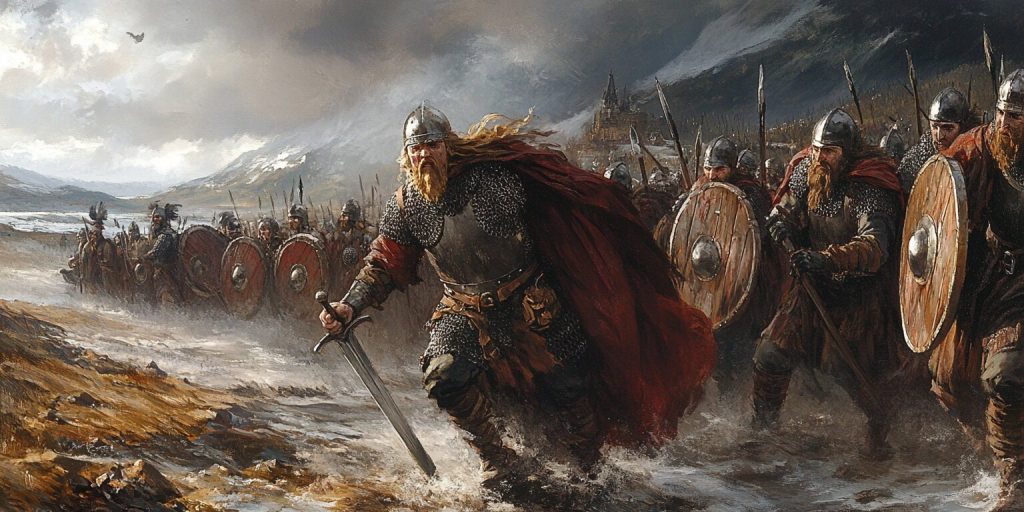Viking Raids and Warfare, Vikings
How Did The Viking Invasion Affect The Monasteries?
The Viking invasion greatly changed monastic life in early medieval Europe. Monasteries were key places for learning and prayer, but they were often attacked because they were wealthy.
Historical records like the Anglo-Saxon Chronicle show how Viking raids affected monasteries. Archaeological finds also tell us about the big impact of these attacks. These events changed the lives of monks and the economy of the time. They marked a hard time in medieval Europe’s history.
So, why did early Viking raiders target monasteries? Keep reading our article to find out.
The Context of the Viking Invasion
The Viking Age lasted from 793 to 1066 AD. It was a time of big changes in Scandinavian history. The Vikings explored, expanded, and had a big impact on Europe.
They went on raids for wealth, land, and resources. This was key to their culture. They were skilled in the sea, which helped them travel and trade far and wide.
Understanding the Viking Age
The Vikings started their raids in the British Isles and then moved to France and the Mediterranean. They had many reasons for these raids, one of which was the need for more land and resources.
Monasteries were often their targets because they contained many valuable things. The Vikings mixed old pagan ways with new Christian beliefs, which shaped their culture and values.
The Role of Monasteries in Early Medieval Society
Monasteries were very important in early medieval times. They were places for spiritual guidance and keeping knowledge safe. They helped spread Christianity and supported farming, which helped communities grow.
Scholars like Bede showed how vital monasteries were, especially in the context of the raids on the island of Lindisfarne. They were key in teaching people to read and write. Inside these monasteries, monks saved important texts. These texts told us about Scandinavian history and shaped the culture back then.
How Did the Viking Invasion Affect The Monasteries?
The Viking raid on Lindisfarne in 793 AD was a key event in history. It’s seen as the start of the Viking Age. This attack scared Christians and showed how weak monastic life was.
The brutal attack was recorded in the Anglo-Saxon Chronicle. It showed the big challenges monastic communities faced during this hard time.

The First Recorded Viking Raid on Lindisfarne
This attack on Lindisfarne shocked everyone. Many monks died or were taken captive during the Viking plunder. The event showed the harsh truth of Viking raids, changing how safe religious places were seen.
The effects of the Lindisfarne attack spread far and wide. It made everyone realize that no holy place was safe from raids.
The Impact on Monastic Life and Practices
Monastic life changed a lot after the first Viking raid, particularly in how it interacted with raiders. Many monasteries saw a drop in religious activities. Monks started focusing more on protecting their places and keeping valuable items.
This led to a major change in monastic communities’ lives. They became more focused on defense and safety, which showed how they were adapting to the dangers of Viking attacks.
Reasons Behind the Targeting of Monasteries
The Viking raids in early medieval times were not just random attacks; they were strategic plunders aimed at settlements. They were planned and focused on specific targets, like monasteries, which shows why monasteries were so attractive to the Vikings.
Why Did the Vikings Raid Monasteries?
Monasteries were key targets for the Vikings for many reasons. They were very wealthy, holding gold, silver, and valuable Christian relics, making them prime targets for raiders. They were often in remote areas with little defense. This made them easy targets for the Vikings.
The Vikings got a lot from raiding monasteries. This made them want to keep doing it.
Valuable Resources and Cultural Significance
Monasteries were more than just places for worship. They were full of cultural treasures. They had big libraries, precious manuscripts, and artifacts showing the history and faith of the time.
The Viking raids led to the loss of these treasures. This affected local communities and all of Europe. Famous people of the time talked about how much these losses hurt society.
Responses to the Viking Threat
The Viking invasions made monasteries rethink their safety plans and start using new defensive methods to stay safe. These changes helped protect the sacred places and the people around them, and monasteries became key places for defending against threats.

Defensive Strategies Implemented by Monasteries
Monastic groups came up with new ways to defend themselves when facing Vikings attack. They did a few things:
- They built strong churches that could stand up to attacks.
- They made stockades and watchtowers to see better and stay safe.
- They set up strong walls to keep monks and local people safe.
These changes showed a new focus on keeping spiritual and worldly treasures safe. Monasteries started to mix their religious life with the need to defend their communities, inspired by figures like Cuthbert and Charlemagne.
The Role of the Church in Mobilizing Resistance
The Church was key in getting people ready to fight against the Vikings. Church leaders helped organize groups to fight back, making everyone feel united and ready.
- They helped create militias from local folks.
- They made sure people knew they needed to defend themselves well.
- They worked with Church and secular leaders, including bishops, to strengthen communities.
This effort made communities stronger. It showed the Church’s role in keeping people safe. The Church gave spiritual support and real help, helping communities stand up to the Vikings.
Conclusion
Viking raids, like the one at Lindisfarne, deeply changed monastic life. They caused a crisis, made monastic life unstable, and forced changes.
These changes reshaped their role in society. The Vikings didn’t just destroy things; they also sought to plunder valuable resources from churches and monasteries. They also started big changes in faith and culture, particularly in churches and monasteries.
Monastic communities didn’t give up. They got stronger and found new ways to protect themselves. They became more spiritual and found new purposes, much like the monks of the island of Lindisfarne.
This helped them survive in a changing world, especially during the beginning of the Viking raids. Their new ways influenced society, marking a big change in medieval Christianity.
The Viking raids had a lasting effect. They changed monastic life and made people think about safety. These changes are still important in medieval Europe’s history, influencing the Frankish territories.
They show how monastic communities adapted and kept going through tough times.

